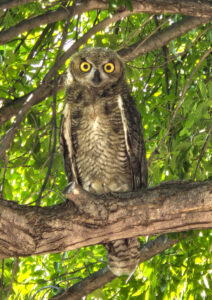It’s one thing to look outside our bedroom window and see several House Finches or Gold Finches. Sure, that happens every day. But, I pulled back the drapes and saw not one, but 5 Great Horned Owls sitting in our Ash tree not 25 feet away. I knew it was going to be a special day.

As it turned out, they were three juveniles and the two parents. It was quite a revelation since they weren’t there the day before. It would have been surprising enough if we had or two followed by the others, but all five came together. Over the next two weeks I got a better understanding of what “together” actually meant.
By the end of that first week, the parents (or so I assume) disappeared and we were left with three youngsters. These three were clearly fledged but had not yet developed the characteristic “horns”. Great Horned Owls are known for their long-term care of the young and I am assuming that I saw the end of that period of care. The young were not yet ready to venture forth on their own. I saw one juvenile busily working on something which I took to be a mouse or some other tasty morsel. Upon closer inspection, it turned out to be a twig from the tree. That bird had a lot to learn about proper nutrition.
Although we only had the adults for a week, the three kids stayed with us in our tree for several weeks. They were flying just fine from the very beginning, so I could only assume that we were witness to the end of “family time”.
Although I have looked, I have never found an owl nest in our neighborhood. Yet, I have heard hoots for years. Where did they come from and where did they go? I have no idea. The biologist in me knows that any large area has a “carrying capacity” which means that our area can only support a finite number of top level predators like owls. I do wonder how three more owls will fit into our neighborhood. Maybe there needs to be an importation of very small dogs?
Learn more about owls here: Juvenile Great Horned Owls (Identification Guide with… | Birdfact
Visit our many hotspots shown here: An Interactive Site Map – Birding in the Verde Valley